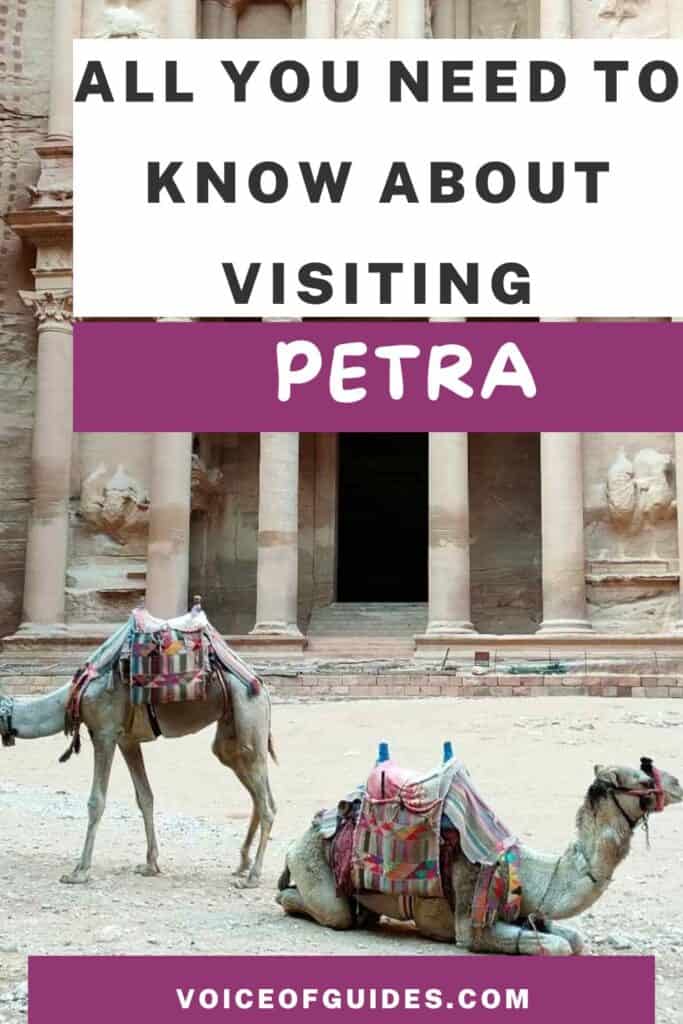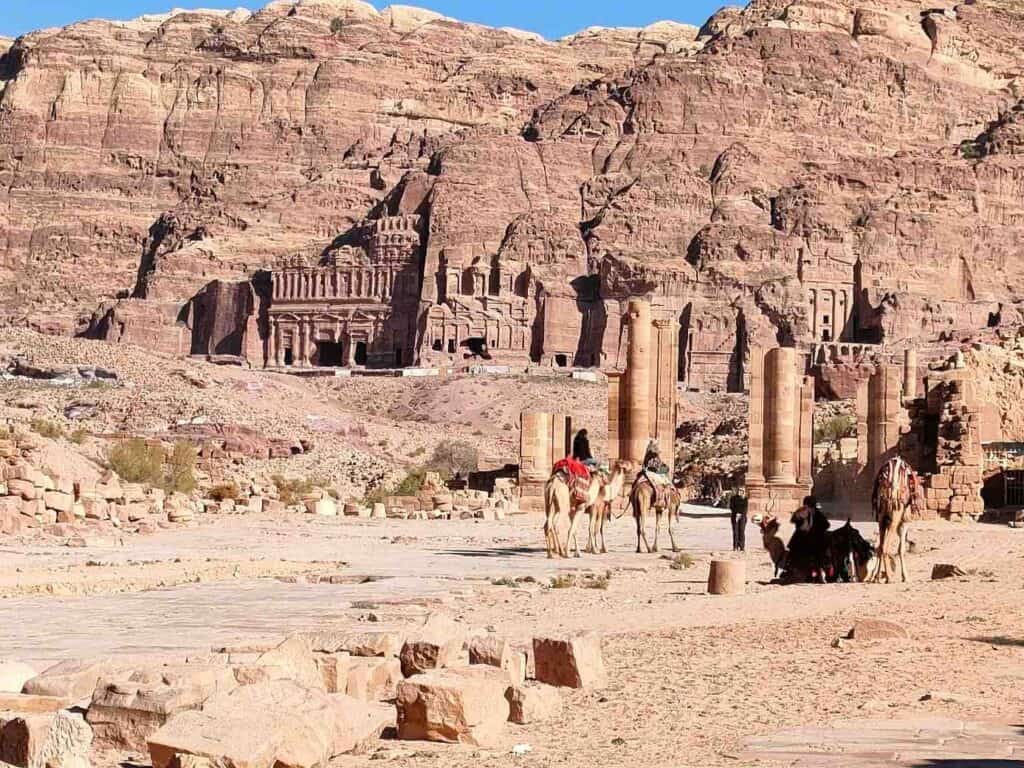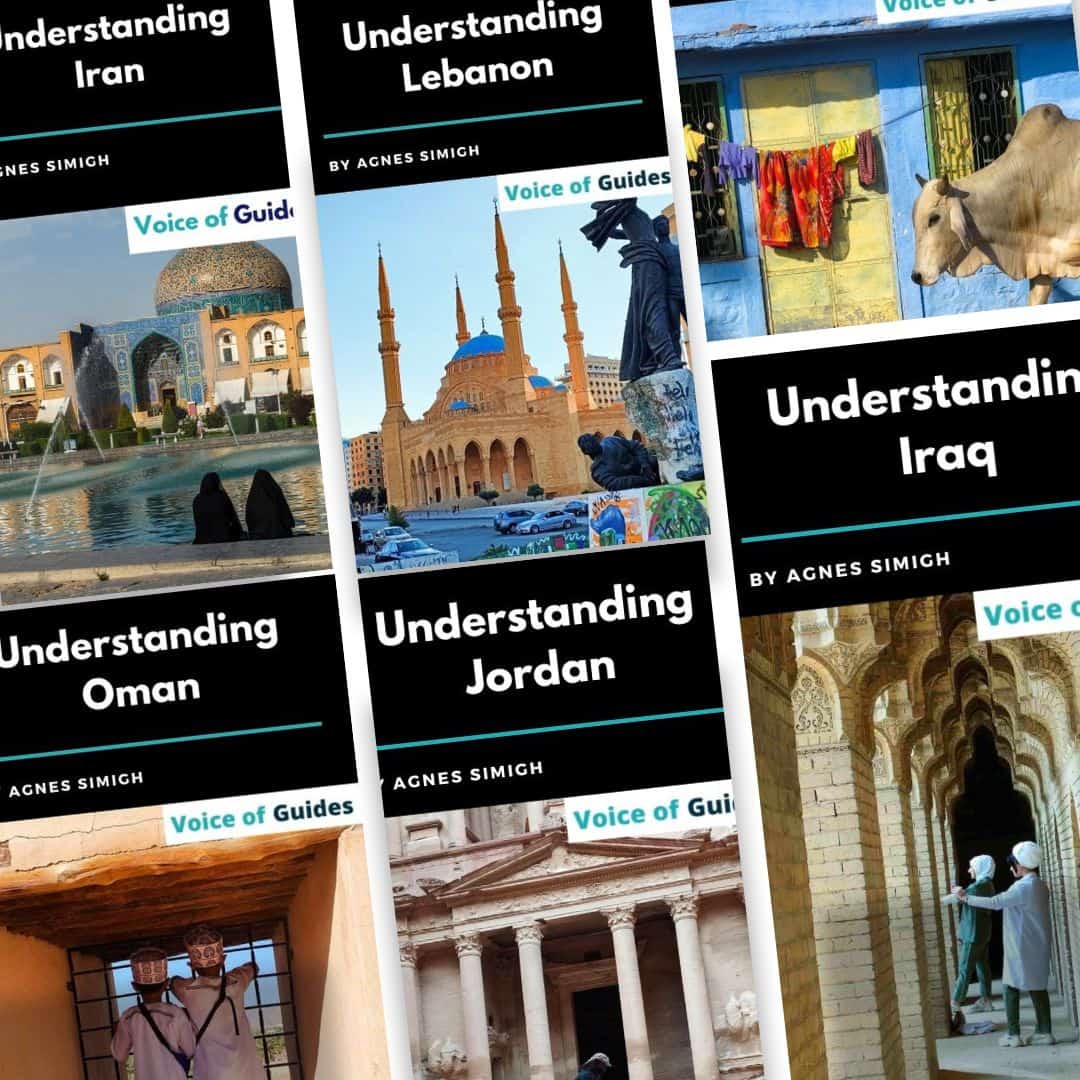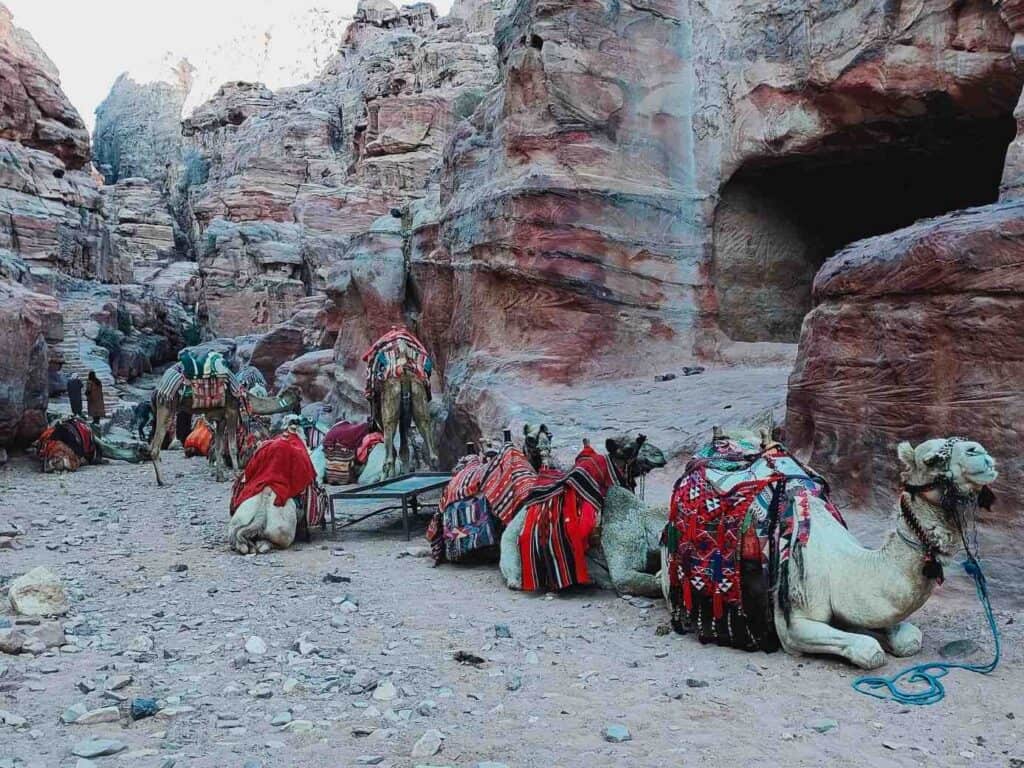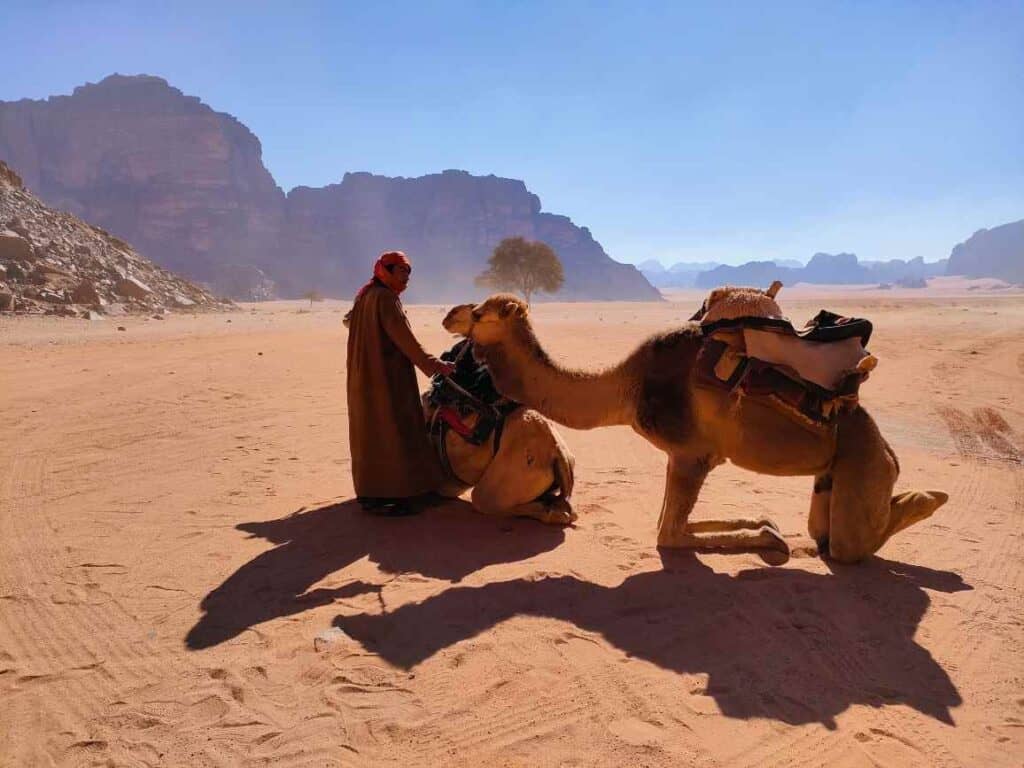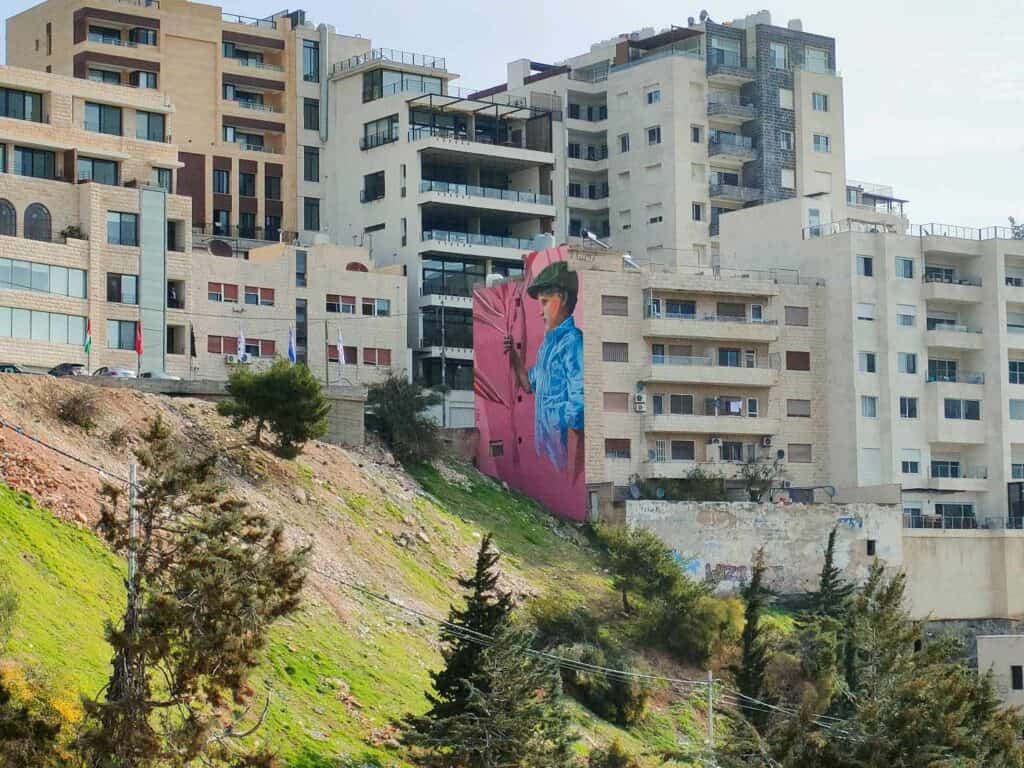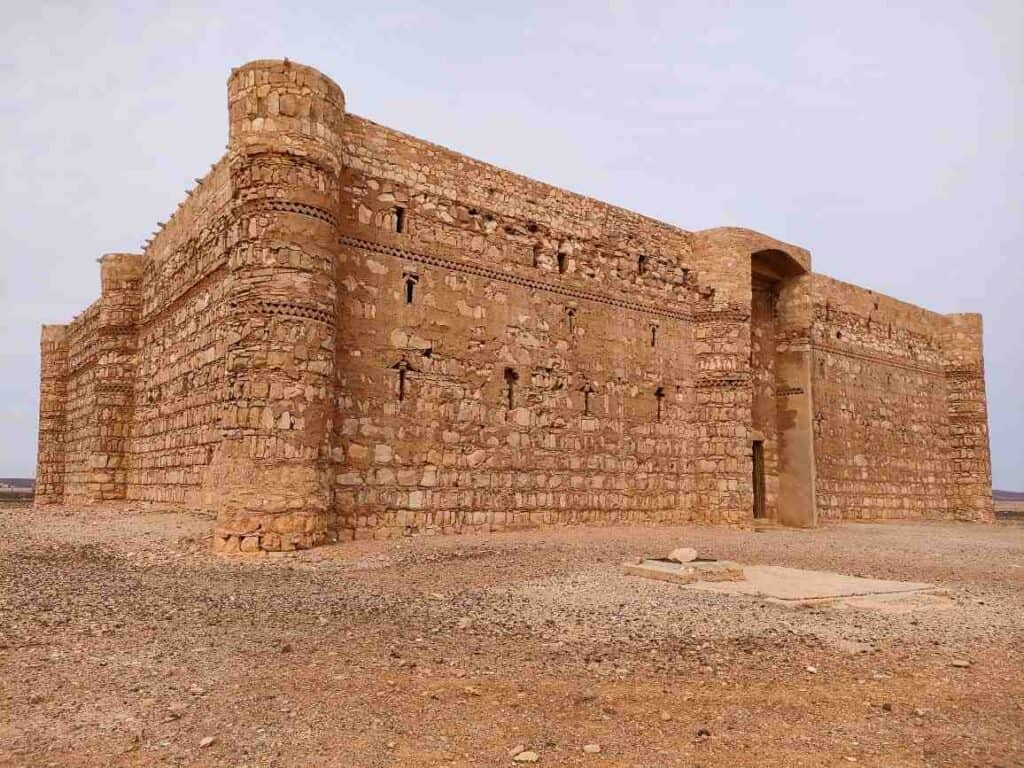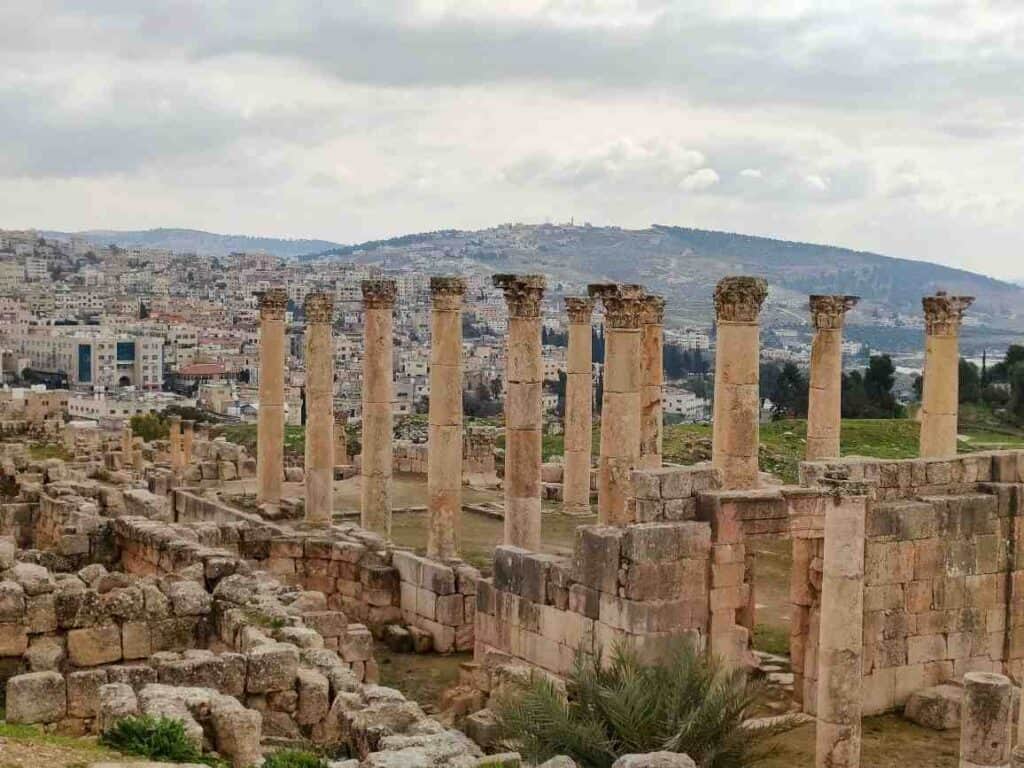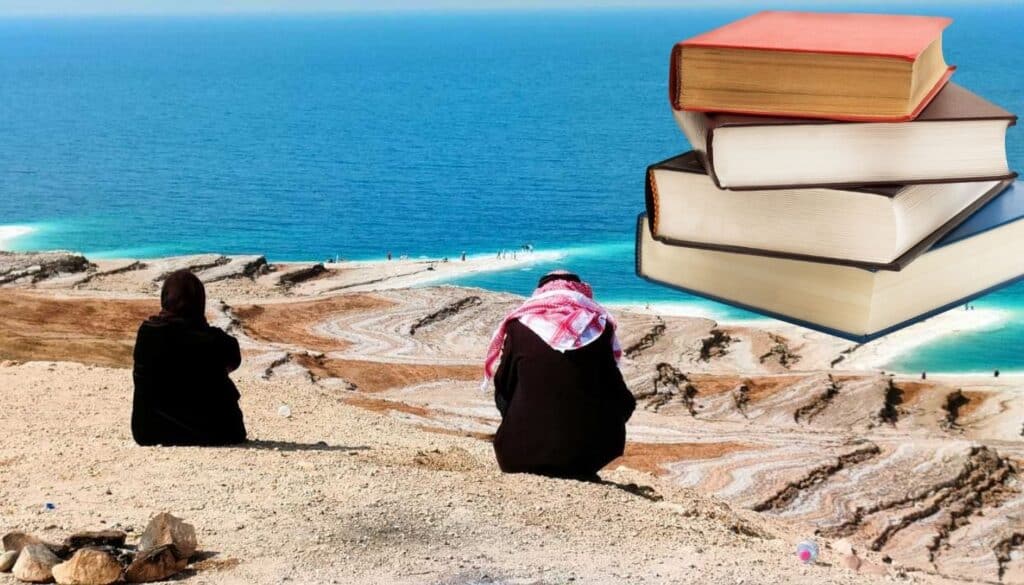This article may contain affiliate / compensated links. For full information, please see our disclaimer here.
Are you planning to visit Petra, the landmark of Jordan, and for many, the only reason to go to the country? There are a couple of things to know more about before planning your Petra itinerary, such as whether to spend one day or two days in Petra, what is the best itinerary, and what you should know about the history of Petra. This travel guide to Petra contains all that is based on my personal experiences as a solo female traveler.
Do you want to visit other places in Jordan? Check out this article about 5, 7 and 10 days Jordan itenaries.
- What is the best time to visit Petra?
- Petra opening hours
- How much does it cost to visit Petra?
- How much time do you need in Petra? Is one day enough for Petra?
- How to get to Petra?
- Where to sleep in Wadi Musa/Petra?
- Where to sleep in Little Petra?
- Sleep in the Bedouin village, Uum Sayhoun
- Important travel tips for visiting Petra in one day
- What you should know about Petra
- Petra in one day itinerary
- Petra 2 days itinerary: how two spend 2 days in Petra?
- The most important attractions you see in Petra
- Enter Petra "for free"?
- Petra by night, is it worth it?
- Other posts about Jordan
- Other posts about the Middle East
- Pin it for later!
- Other posts about Jordan
What is the best time to visit Petra?
The recommended time to visit Jordan is in spring and autumn when the temperature is moderate. This also applies to Petra, although it lies at an altitude of approximately 900 meters. Summer can be unbearably hot for walking all day as the temperature can rise to over 40 degrees. It can be pretty cold in winter, and although it rarely happens, it can snow and rain during winter. If that happens, they even close Petra for visitors as the slippery rocks get dangerous.
At the same time, there are so many tourists in Jordan during the peak season (autumn and spring), especially in Petra. It is always beautiful, right, but it is not the same when you can enjoy that in tranquility.
For all that, the best time to visit Jordan is outside the peak season but not in the middle of winter. October, November, February, and March could be the perfect choice when an even slightly cooler temperature makes it ideal for long distances in Petra, or it may not be cold at all during the day. Expect the temperature to drop in the mornings and the evenings.
Important: If you plan to combine your visit to Petra with hiking in Wadis, this is not the best time to go to Petra since wadis are closed from November till March.
How to plan your trip to Jordan?
Flights: find the best flight deals on Skyscanner
Rent a car: Check Discover Cars‘ deals for driving around in Jordan (the best way to discover the country)
Insurance: Safetywing is a cheap insurance that covers all medical issues, including COVID-related ones. This is what I use every time.
Hotel/Hostel: Booking.com
Local tours and guides in Jordan: Toursbylocals, GetYourGuide and Viator offer several customized tours to Petra
Petra opening hours
Summertime (May-October): 6 am to 6 pm
Wintertime (November – April): 6 am to 4 pm
You must leave Petra by sunset for security reasons and also because of the “Petra by night program”, for which they charge an extra fee (17JOD~24$). The security staff goes around the area with torches to check if any tourists are inside.
How much does it cost to visit Petra?
Visiting Petra is quite expensive. Jordanians are aware that this is Jordan’s highlight, and tourists are willing to pay whatever they need to see that. Or maybe this is what it costs to maintain Petra. However, everything that serves tourists in Jordan is much more expensive than when you leave the touristic trail making Jordan a more expensive country to visit in the Middle East and harder to travel on a budget.
The entrance fee to Petra costs
– JD50 (~70$) for one day
– JD55(~77$) for two days
– JD60(~84$) for three or four days.
The multi-day tickets apply to consecutive days. The Jordan Pass (valid for the visa for certain countries + multiple entrance fees) has three different prices depending on how many days you spend in Petra.
With one-day entry to Petra: 70 JOD~ 99 USD
With two days entry to Petra: 75 JOD~ 106 USD
With three days entry to Petra: 80 JOD ~113 USD
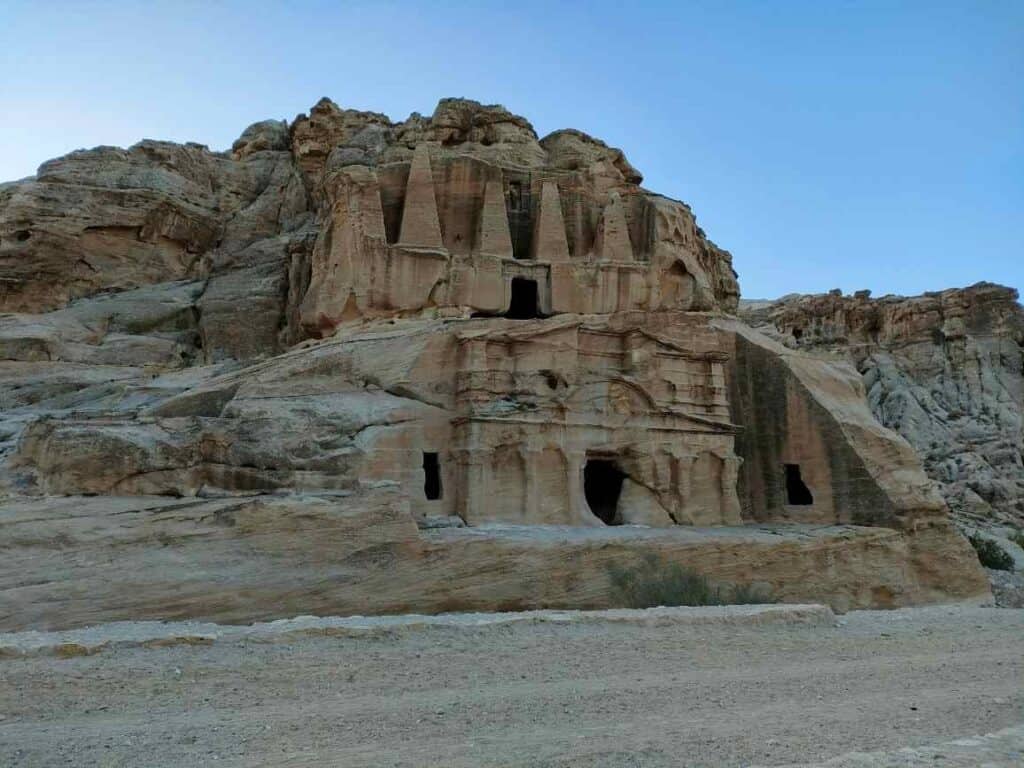
How much time do you need in Petra? Is one day enough for Petra?
It depends. If you are fit, love hiking, and have the time, I recommend planning two days in Petra. You can include everything important in a two days itinerary. However, if you only have one day in Petra, you can still see plenty of things if you don’t mind starting early and walking a lot.
If you are not fit, don’t like walking that much, and are satisfied with the popular touristic route, then one day in Petra should be enough. But even then, spend more than a couple of hours there to get the feeling of Petra. Remember: don’t only visit, but understand the place as well.
All you need to know before planning a trip to Jordan
How to get to Petra?
With public transport
1. From Aqaba to Wadi Musa/Petra (127km)
there is one daily Jett bus from Aqaba with a stop in Wadi Rum at 8 am every morning from the bus station near Hotel Mövenpick in Aqaba. The same bus continues from Wadi Rum to Wadi Musa-Petra (2 hours). It starts at 9 am from Wadi Rum.
The bus costs 15 JOD (almost 3 hours), which is not especially cheap for public transport. But since most tourists use this route, they charge a lot more than on public transport between less touristic places.
You can only buy your ticket on the same day, so show up at 7:30 am at the counter in Aqaba. If you want to catch the bus from Wadi Rum, ask your camp staff to take you to the bus on time.
The bus is not fast; it stops for a photo before Wadi Rum at the Hejaz railway and along the highway, hoping the tourists will buy some souvenirs. That’s why it takes 3 hours to get from Aqaba to Wadi Musa.
So, if you are linked to public transport, you lose a lot of time departing from Aqaba/Wadi Rum.
The daily Jett bus returns from Wadi Musa/Petra to Aqaba at 5 pm. It means that making a day trip from Aqaba to Petra may not be the best choice, especially considering the expensive entrance fee to Petra. However, it can be enough if you only want to see the main points without walking much.
2. From Amman to Petra (235 km)
The daily Jett bus leaves at 6:30 to Wadi Musa, takes 3 hours and costs 10 JOD.
The daily Jett bus leaves at 17:00 from Wadi Musa to Amman.
Take a local tour of Petra
There are several day trips to Petra from Aqaba and Amman in Jordan.
But you can even visit Petra on a day trip from Israel (Eilat, Tel Aviv, and Jerusalem) or Egypt (Dahab, Sharm-el Sheikh), which are, of course, costlier but possible.
Check the day and multi-day trips to Petra here
With rented car
Driving your car is the easiest way to get to Petra and, generally, to get around Jordan, as public transport is limited.
Find a good deal to rent a car for your trip in Jordan
Where to sleep in Wadi Musa/Petra?
Petra is an archeological site, and tourists can stay nearby Wadi Musa, which has a range of guesthouses, good hotels, restaurants and souvenir shops.
Low-budget hostels/hotels
Rafiki hostel is probably the best low-budget guesthouse in Petra, with dormitories and private rooms. On the top floor is a community room where you can spend the evening with other travelers, have a cup of tea, and smoke shisha. On specific days, the hostel cooks local specialties for which you can sign up. They organize local tours to nearby Little Petra or the Dead Sea. The manager gives you all the information on the upcoming tours, transport and tips on how to visit Petra. This is where I stayed two nights as a solo female traveler. It is only a short walk from the entrance to Petra and easy to find if you arrive with the daily bus from Aqaba/Wadi Rum.
Nomads Hotel Petra: Another low-budget place to stay with dormitories and private rooms with an excellent location close to the Petra Visitors Center.
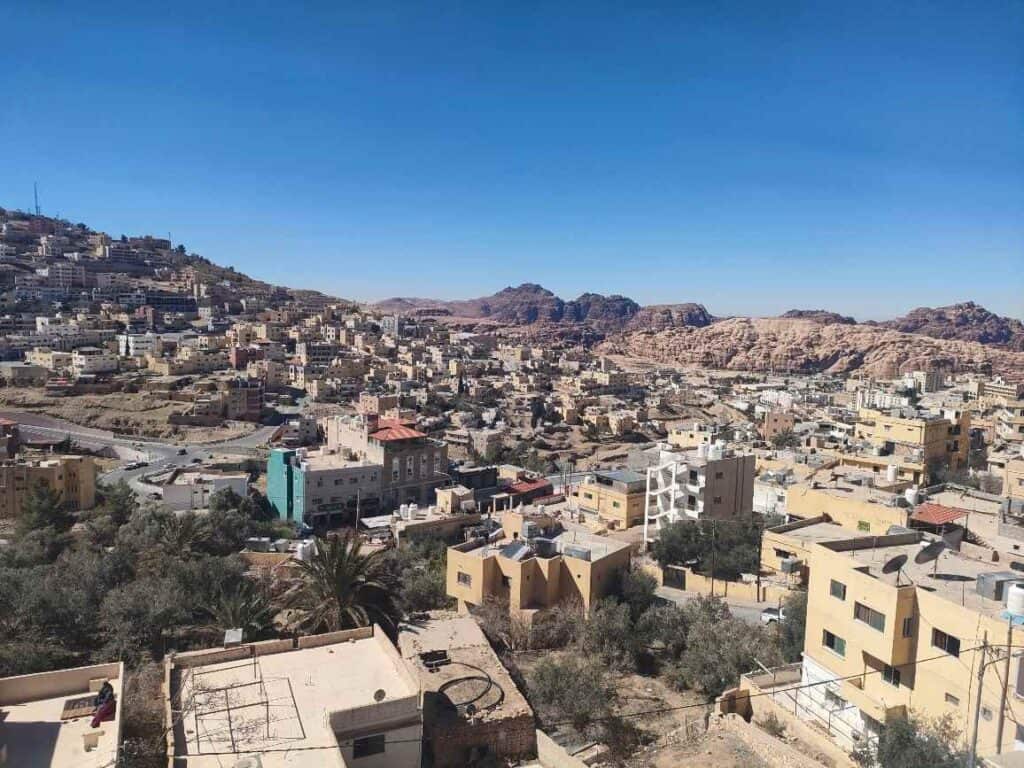
Mid-range hotels
Hotel Esperanza has an excellent location close to the visitor center and positive feedback from travelers.
Petra Jewel Luxury hotel: Only 5 minutes walk from the visitor’s center, this new hotel has a panoramic view.
Tatra tree hotel: in the center of Wadi Musa, a modern hotel and restaurant on the top with an excellent view.
High-range hotels
Petra Guest House Hotel is close to the visitor center, and part of the hotel is the Cave bar, a stylish pub in a 2000-yer old tomb.
Where to sleep in Little Petra?
Sleep in the Bedouin village, Uum Sayhoun
5-6 km from Wadi Musa is Uum Sayhoun, the village, where the Bedouins of Petra have lives since the ruin city has been converted into a tourist attraction.
If you are looking for an authentic experience, stay in the Happy Bedouin House Petra in Umm Sayhoun.
Important travel tips for visiting Petra in one day
– Stay for 2 nights in Wadi Musa/Petra and use the entire day to visit side paths and hidden gems and interact with locals. It is tiring, but you can have a rest, and this is how you get the feeling of the iconic tourist attraction of Jordan, for which you most probably decided to go to the country.
– Start early, at 6 am or as soon as it gets lighter. To be able to start early without having to join the line for the ticket purchase, the best you have a Jordan Pass, or you already have your ticket purchased before
– Know that the donkey ride is not included in your entrance fee from the visitor’s center to the entrance of the Siq
– Donkeys take tourists up the steep stairs and seem to suffer from carrying big weight. So unless you really need it, you should not ride the donkeys for fun.
– Prepare well for your day in Petra as you cannot simply return to your hotel if you forget something: have comfortable shoes, protect yourself against the sun, and bring water if you leave the main trail.
– There is only one restaurant inside Petra, The Basin, at the end of the Main trail (quite costly). If you are hiking, it is better to pack something and have a picnic wherever you like. At the same time, you can enjoy the unique landscape
– Don’t be afraid to accept a Bedouin’s invitation to have tea while visiting Petra. They are hospitable; it is part of their culture and a good experience for you.
– Keep the closing time in mind, especially if you go during winter to get out of Petra before sunset.
– Don’t lose your patience with the sellers and voluntary tour guides, who can sometimes be pushy
– It is not hard to get lost in Petra if you leave the main route. But even on the side trail at the major points (High Place of Sacrifice and obelisk), the Bedouins selling their crafts can guide you.
– Discover Petra on your own: I generally find local tours and guides of great value not only to visit but understand a place, but the best way to discover Petra is to walk around alone. All you need is a map that you can grab at the Petra Visitors Center that indicates the trails and sights, and read about the attraction in Petra in your travel guide. It is such a different experience to take alone off-the-beaten-track places, stop to chat with locals, and immerse in the magic of Petra.
What you should know about Petra
Petra was a flourishing trade and caravan center hub between the 5th century BC and the 3rd century AD. Hidden among desert rocks, it was once a prominent city of an Arab tribe called the Nabataeans. In the 6th-5th centuries BC, the Semitic people from Asia, the Nabataeans, conquered Edom and brought the trade on the section of the Silk Road from Damascus to the Gulf of Aqaba under their control.
Petra is at the junction of three valleys between the mountains, the Dead Sea and the Gulf of Aqaba. In this isolated, hard-to-reach valley closed by rock walls, two ancient caravan routes crossed each other. Due to its protected location and good water supply, they built an artificial oasis, Petra. The Nabateans built a complex network of canals to divert rainwater from the Siq and to make the surrounding land cultivable. According to the legends, Moses touched the rocks of the famous Siq (the gorge leading to Petra) with his stick and created water for his people after he led them out of Egypt. This water was essential for life in Petra.
How to plan your trip to Jordan?
Flights: find the best flight deals on Skyscanner
Rent a car: Check Discover Cars‘ deals for driving around in Jordan (the best way to discover the country)
Insurance: Safetywing is a cheap insurance that covers all medical issues, including COVID-related ones. This is what I use every time.
Hotel/Hostel: Booking.com
Local tours and guides in Jordan: Toursbylocals, GetYourGuide and Viator offer several customized tours to Petra
Most of the monuments in Petra are tombs (the earliest from the 3rd century BC), so for a long time, they thought that Petra was nothing more than a vast necropolis. There were residential areas, but they didn’t survive. The Nabateans lived in simple tents for a long time, like their later successors, the Bedouins. Their size and decoration reflected the customer’s status.
Ordinary people were buried in rock-cut cavities, while the rich built royal tomb-like monuments. The Nabateans were much better sculptors than architects. They realized that the simplest way of construction was to carve the sandstone. They also thought that the individual buildings were victims of earthquakes anyway.
The larger tombs were carved from top to bottom with the help of scaffolding attached to the stones. Except for the simplest cave tombs, the tombs also included a dining room (triclinium), where a funeral feast was served in honor of the deceased, and they held annual commemorations. The Nabataeans did not develop their own architectural style as desert people. Still, their merchants traveled throughout most of the ancient East and adopted artistic elements, which makes Petra a strange mixture of Egyptian, Assyrian, Mesopotamian, Hellenistic and Roman styles.
The golden age of Petra
Petra, a luxury retreat for merchants, became the capital of the Nabateans and lived its heyday between 200BC and 100AC. The Nabateans carved elegant, monumental buildings, churches, baths, residences, and tombs from the stone walls. They conquered Damascus and Jerusalem until the Romans gave a halt to their further expansion plans. Marcus Aurelius recaptured Jerusalem and pushed as far as Petra but failed to annex it. The Nabateans became vassals of Rome but maintained their internal autonomy for another 200 years, and Petra grew until the end of the 1st century. During its golden age, the city had 20-30 000 inhabitants.
The decay of Petra
When new caravan routes were opened north of Petra, and maritime trade became more popular than land transport, Petra started to decline. The last Nabatean king left Petra and moved his headquarters to the northern capital of his empire, in today’s Syria. In 106, Trajan finally conquered the Nabatean kingdom and made it his province under the name of Arabia Petraea. Petra’s trade relations collapsed, and Palmyra took over the supervision of the new caravan routes. Although the city lost prestige, it still developed architecturally during this time. The Roman theater, the columned road, triumphal arches, new baths, and the nymphaeum were built during this period. Petra was destroyed by two great earthquakes in 363 and 551, after which it was depopulated.
When Christianity spread, the “Tomb of Uma” was turned into a church and the city became the episcopal seat. After 395, it belonged to the Eastern Roman Byzantine Empire until the Arab conquest in 634. The Arab conquerors drove out the inhabitants in 663 and destroyed a significant part of Petra’s buildings. During the Crusades 1099 – 1291, it played a strategic role, but after the capture of the Kingdom of Jerusalem, it was depopulated.
From the 7th century, it suddenly declined, and only the Bedouin shepherds knew about its existence. Its last European visitors were the Crusaders, and in 1812, the Swiss explorer Jean Louis Burckhardt found it again under adventurous conditions during one of his trips.
Why does Petra have pink-red color?
The Wadi Musa valley is built of sandstone; the minerals found in the rock dissolve on the surface and paint it in different colors. The dominant pink and reddish color is caused by iron, yellow by sulfur, green by copper, white by clay, and gray and black by magnesium.
Rediscovery of Petra
After the Crusades, no Europeans came to Petra until the 1800s. In 1812, Swiss explorer and Arabist Jean Louis Burckhardt was the first to reach and make it known again with the help of his Bedouin guide. He made notes and drawings, and more than 100 years later, in 1916, Lawrence of Arabia, who fought here in the service of British military interests during the Second World War, revisited Petra.
Its archaeological excavation began in the 1920s and was opened to tourists a little later. After Buchardt’s observations, more and more researchers, adventurers, and travelers arrived. Jean Louis Burckhardt was familiar with Arabic culture, the language, and the Quran, so he could travel in the region without any problems. He was the first European who, after a strict religious test, was allowed to enter Mecca and Medina in Muslim dress. Burckhardt heard from his companion about the lost, inaccessible, mysterious city on his way from Aleppo in Syria to Egypt. He pretended to be a Muslim and was accepted by the local Bedouins, calling himself Ibrahim ibn Abdullah. Under some pretext he entered Petra with two Bedouins on 22nd August 1822, where he took advantage of his Arab attire to make drawings and notes secretly.
“The ruins of Wadi Mousa probably are that of ancient Petra.” – he wrote.
As soon as the drawings spread, Western visitors flocked to the ruin city. Later, while visiting Egypt, he discovered Abu Simbel and made a pilgrimage to Mecca. In 1817, he contracted dysentery during a trip to the desert and died at the age of 33. He was buried in Cairo, and his Arabic name was recorded on his tombstone.
Until now, only 5% of Petra has been discovered.
The Bedouins of Petra and the beginning of tourism
Modern tourism began in the 1930s, when the first hotels were built, some in the ruined city, right next to the Roman theater. They have since been demolished. The Jordanian government evicted the inhabitants of the Bedul Bedouin tribe from the area in 1968-1985, who used the rock caves of Petra as housing. They moved to the nearby Umm Sayhoun village, where every Bedouin family got a house from the government. The Bedouins go to work in Petra every day. Some families still live inside Petra in caves or houses. They sell souvenirs, work as tour guides, and offer donkey, horse, or camel rides for tourists. It is not uncommon for Bedouins to marry Western women after meeting in Petra. The most famous lady is the New Zealand-born nurse Marguerite van Geldermalsen, who became the wife of Mohammad Abdallah Othman, a Bedouin, and wrote her story about adjusting to the new lifestyle in her book: “Married to a Bedouin”.
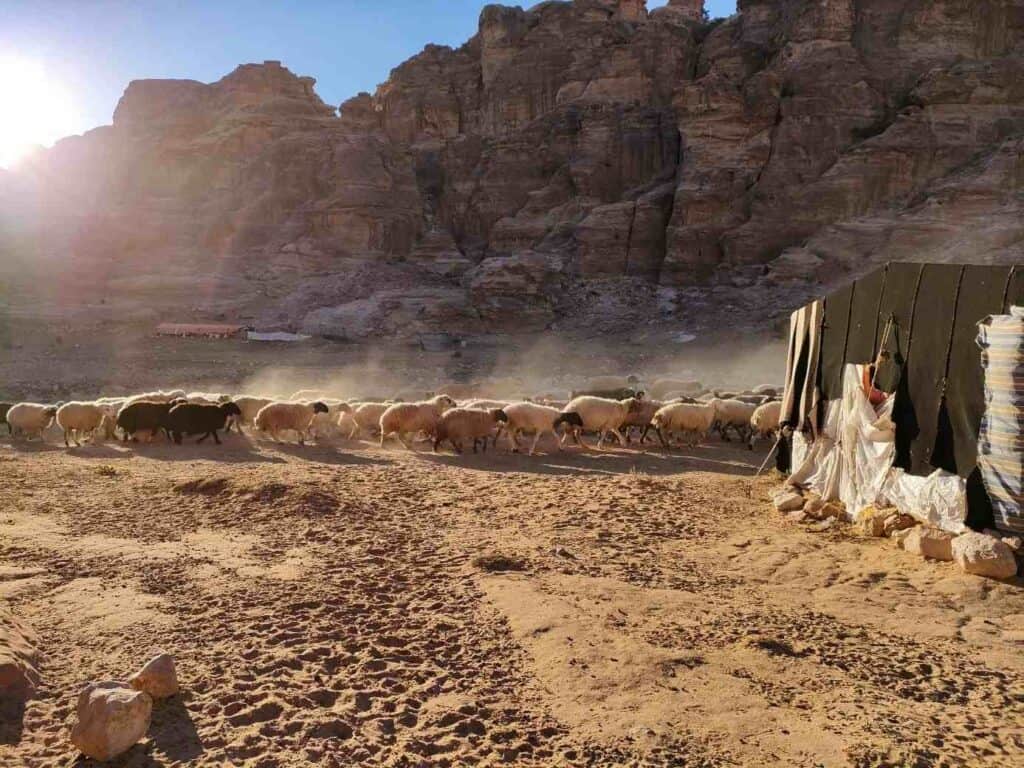
Shopkeepers often have copies of the book. She is a widow but still lives in Umm Sayhoun when not in New Zealand and has been entirely accepted by the Bedouins.
The Egyptian-Israeli peace in 1979 boosted the number of visitors to Petra. It became a cultural world heritage site in 1985, and Steven Spielberg’s “Indiana Jones and the Last Crusade” made it extremely popular in America and Europe in the 1990s. This was when modern touristic infrastructure was established.
The Israeli-Jordanian peace treaty in 1994 gave another boost to tourism and most visitors came from Israel or the West Bank. However, the deepening Israeli-Palestinian crisis and the events of 9/11 set back tourism.
Until now there are Bedouins who live permanently inside Petra. You can especially find them along the Haroun trail.
If you are looking for an authentic experience, stay in the Happy Bedouin House Petra in Umm Sayhoun.
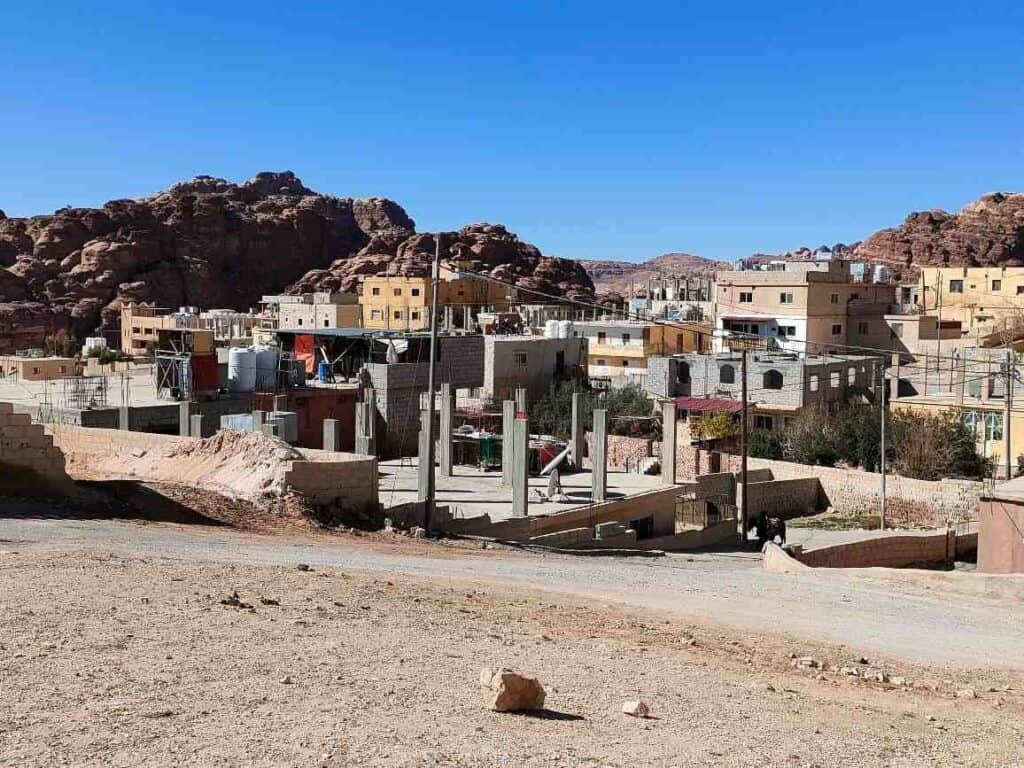
Petra in danger
Due to centuries of abandonment, earthquakes, and erosion, the once solid canal system is ruining the Siq and the ruins, the foundations of the walls are flooded by salty groundwater. As the walls absorb this water, it destroys the sandstone. The Treasury’s condition visibly deteriorates. Thanks to the help from foreign governmental and civil organizations, the most urgent restoration work along the Siq of the canal network have already been made. They also clean and stabilize the facades of the graves.
The huge number of tourists damaged the surfaces. At the same time, the humidity of the air inside the most famous tombs increased, and travelers climbed on top of crumbling tombs and steep hillsides, accelerating natural erosion.
Petra in one day itinerary
If you only have one day in Petra, I recommend the following program, depending on your fitness and interest. The first is a more relaxed route that you can easily cover in one day in Petra. The second is a more intensive program, for which you need to start early and hike more, making the most of your day.
Both trails start at the Petra Visitors Center.
Bedouins are waiting with their horses at the visitor center and offer to take you to the entrance of the Siq. As mentioned above, they say it is included in the entrance fee, but in the end, they charge you some money.
1. Main trail + Al-Khubtha (Treasury Overlook Trail) + Monastery Trail (Easy Version)
Visit the Bab Al Siq and Djinn Rocks, the Obelisk tomb, the Siq, The Treasury, The Street of Facades, the Theater along the Main Trail, the most visited trail in Petra.
After that, join the Treasury Viewpoint Trail.
When you reach the royal tombs, follow the path to the café with a stunning view of the Treasury. This is where most tourists have their popular photos taken. On the way will pass the Al-Khubtha High Place and Cistern. You must return to the Main Trail and pass along the Street of Colonnades, the Great Temple, the Byzantine temple, and the Girl’s Palace.
At the end of the Main Trail, take the Monastery Trail (Ad-Deir Trail) to the Museum. The 800 steps lead you to the Monastery. After a short hike, it branches off to the left, where you can visit the Lion Triclinium. Return from here and continue to the Monastery on the top.
You either return through the Main Trail to the Visitor Center or take a shorter route and leave through Little Petra from the bottom of the Monastery Trail. Ask some Bedouins about the way. In this case, you need to catch a car from the main road back to Wadi Musa, which should not be a problem.
Main Trail
Difficulty: moderate
Duration: 1.5 hours return
Distance: 4 km
Difficulty: easy
Duration: 1-1.5 hours
Treasury Overlook trail
Difficulty: moderate
Duration: 1.5 hours return
Monastery Trail
Duration: 45 minutes – 1 hour
Difficulty: hard
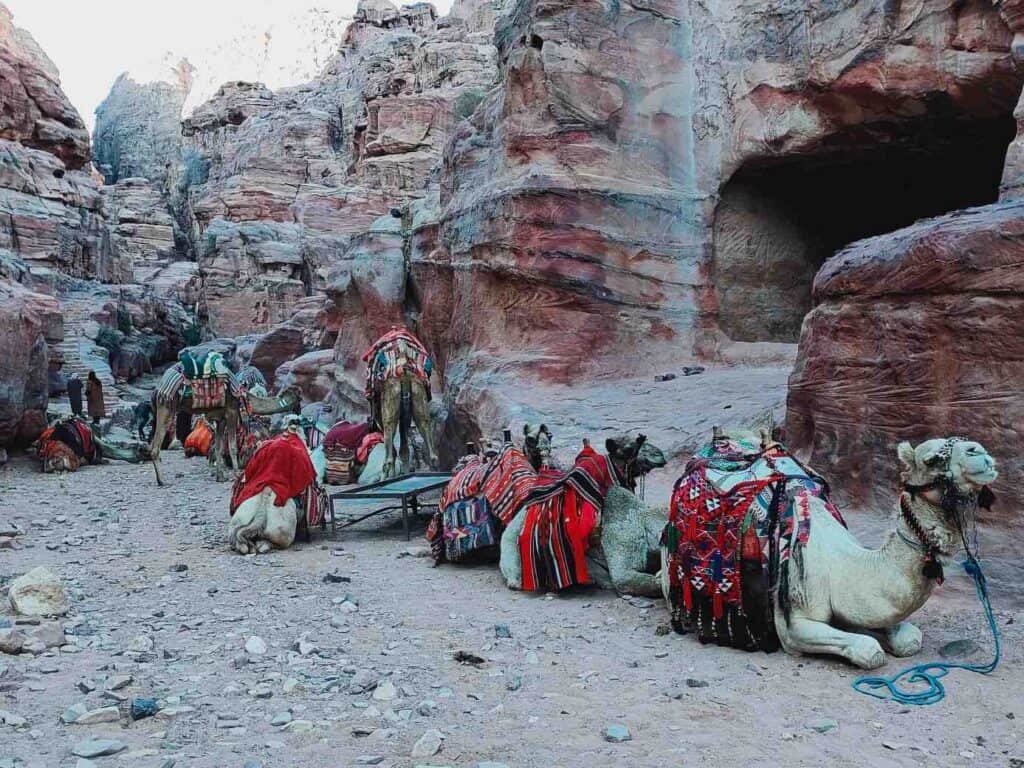
2. Al-Khubtha (Treasury Overlook Trail) + High Place of Sacrifice Trail + Al-Farasa Trail+ Monastery Trail (Difficult version)
Visit the Bab Al Siq and Djinn Rocks, the Obelisk tomb, the Siq, The Treasury, The Street of Facades, and the Theater along the Main Trail.
After that, join the Treasury Viewpoint Trail.
When you reach the royal tombs, follow the path to the café with a stunning view of the Treasury. This is where most tourists have their popular photos taken. On the way will pass the Al-Khubtha High Place and Cistern. You have to return to the main trail from here.
Next to the theater starts the High Place of Sacrifice Trail.
After reaching the high Place of Sacrifice, you can continue along the Wadi Farasa Trail, a secluded canyon that leads you to the end of the Main Trail from the top.
You come across some hidden gems of Petra, like the Soldier’s tomb, the Lion Fountain, the Garden Temple, and the Renaissance tomb.
Take the Monastery Trail at the end of the day.
You either return through the Main Trail to the Visitor Center or take a shorter route and leave through Little Petra from the bottom of the Monastery Trail. Ask some Bedouins about the way. In this case, you need to catch a car from the main road back to Wadi Musa, which should not be a problem.
The high Place of Sacrifice trail
Duration: 45 minutes
Difficulty: hard
Wadi Farasa Trail
Duration: 1 hour
Difficulty: easy
Petra 2 days itinerary: how two spend 2 days in Petra?
Day 1: Main trail + Al-Khubtha (Treasury Overlook Trail) + Monastery Trail (See above for the one-day itinerary for Petra)
Day 2: Jabal Haroun Trail
Take the main trail till Qasr Al-Bint (Girl’s Palace) from the main entrance and join the Jabal Haroun Trail that takes you to the tomb of Aaron, the tomb of Moses who is supposed to be buried here on top of the mountain (1400m). There is a small white chapel on the top. This place offers the best view of Petra.
You either return through the Main Trail to the Visitor Center or take a shorter route and leave through Little Petra from the bottom of the Monastery Trail. Ask some Bedouins about the way. In this case, you need to catch a car from the main road back to Wadi Musa, which should not be a problem.
Jabal Haroun Trail
Duration: 6 hours
Difficulty: Hard
Return to the start of the Monastery Trail.
The most important attractions you see in Petra
Bab Al Siq and Djinn rocks
It is the gateway to the Siq with three massive Djinn rocks, some of the oldest monuments in Petra dating back to the 2nd century BC. They may embody the gods, perhaps the spirits. The three giant monolithic rock blocks were carved out of the rock by spirits. However, in reality, they are unfinished tombs. Some scholars dispute whether the tombs are dedicated to the Nabataean deity, Dushara.
Obelisk tomb
The obelisk from the 1st century shows an Egyptian influence. The cult of the Nabatean god Dushara was widespread in Alexandria, Egypt. The facade consists of 4 obelisks or pyramids carved into the rock, and each pyramid is a symbolic representation of a dead person. The obelisk is a traditional symbol of the power of the Nabateans, which expressed authority. The triclinium is an undecorated room to celebrate feasts in honor of the dead.
The Siq
A 1.2 km long gorge leads to Petra, 80-100 meters high and only 2-3 meters wide in some places. Approaching Petra through the Siq is magical. The colors are stunning and constantly changing in the different shades of red and brown.
According to the legend, Moses touched the rock with his stick at the entrance, and water sprang for the thirsty Jewish people during their journey after the liberation from Egypt. Aqueducts made of stone ran along the road that carried the water from Wadi Musa to Petra.
The many votive niches and divine shrines suggest that the Siq may have been a holy place. Parades were held in the canyon on the most important Nabatean holidays, and the Nabatean pilgrimage routes led here. The small shrines in the gorge foretell the more ornate churches in the city center.
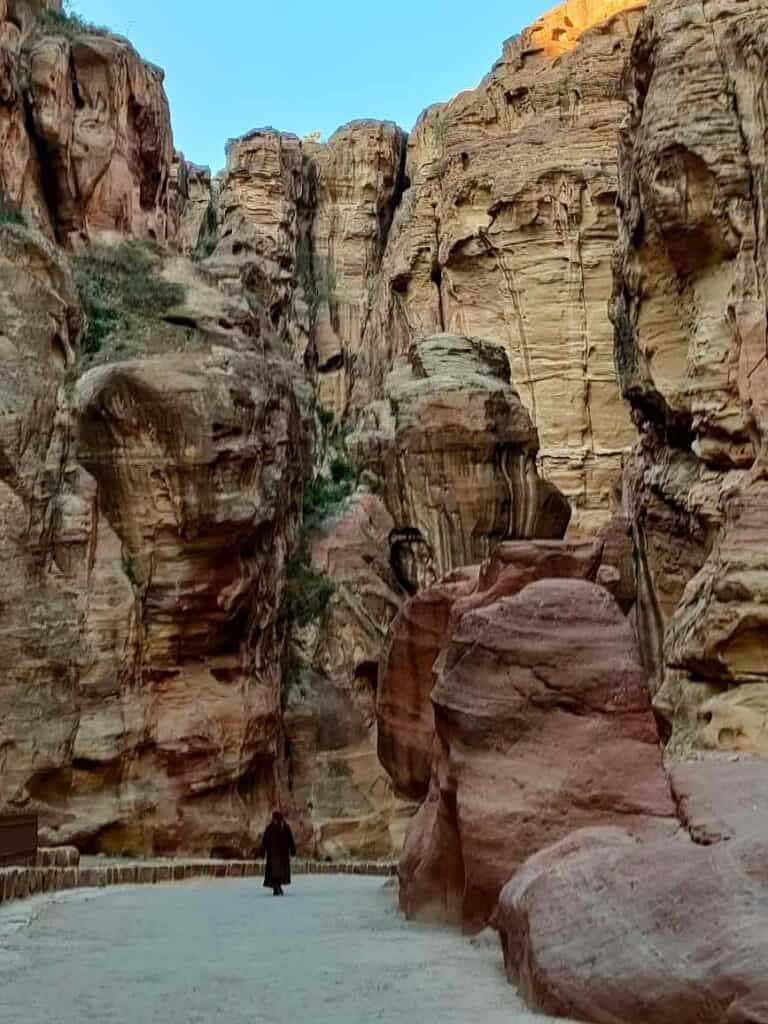
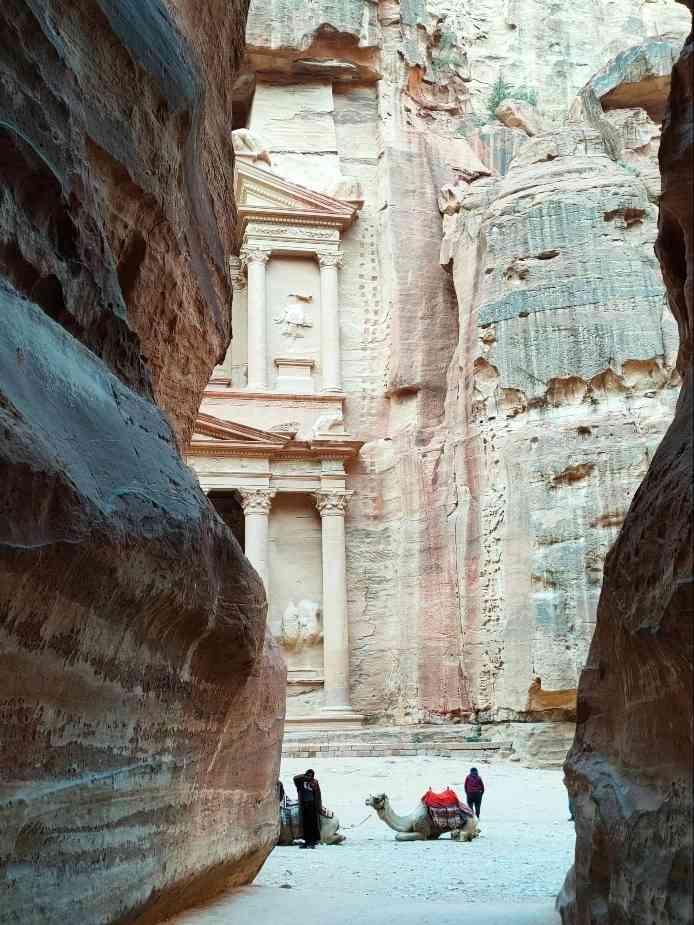
Treasury (Al-Khazneh) – the main attraction of Petra
The Treasury is the Nabatean architecture’s symbol, the most famous attraction in Petra that stunningly opens up at the end of the Siq. At dawn and dusk, the sandstone has a particular pink hue. Between 9 and 10 a.m., the facade gets enveloped in light. It was probably the tomb of the Nabatean king Aretas III, but according to other historians, it was built later, during Aretas IV or Emperor Hadrian in the 2nd century.
Like a typical Nabataean tomb or church, they built it from top to bottom, hollowing out the rocks. The facade depicts Nabatean gods, goddesses, other mythological figures, dancing amazons, flower garlands, wine glasses, griffins and vines. The entire structure remained in excellent condition.
Tip: If you start early morning, you can have the Siq and the Treasury almost only for yourself and see the changing colors with the sun going up.
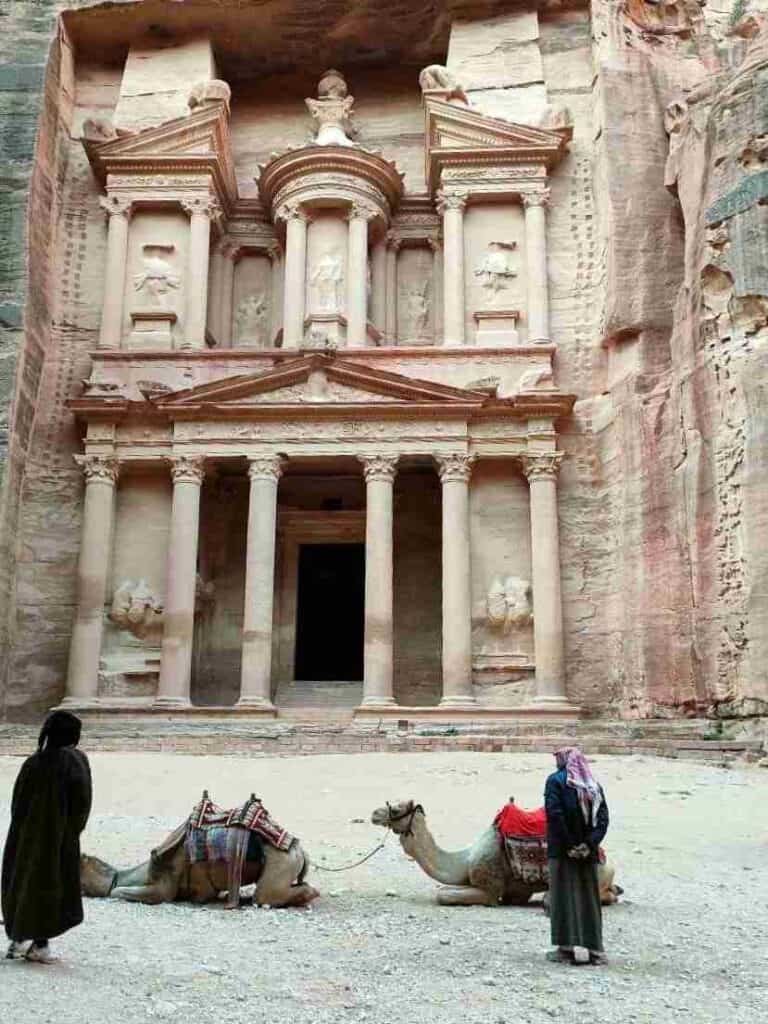
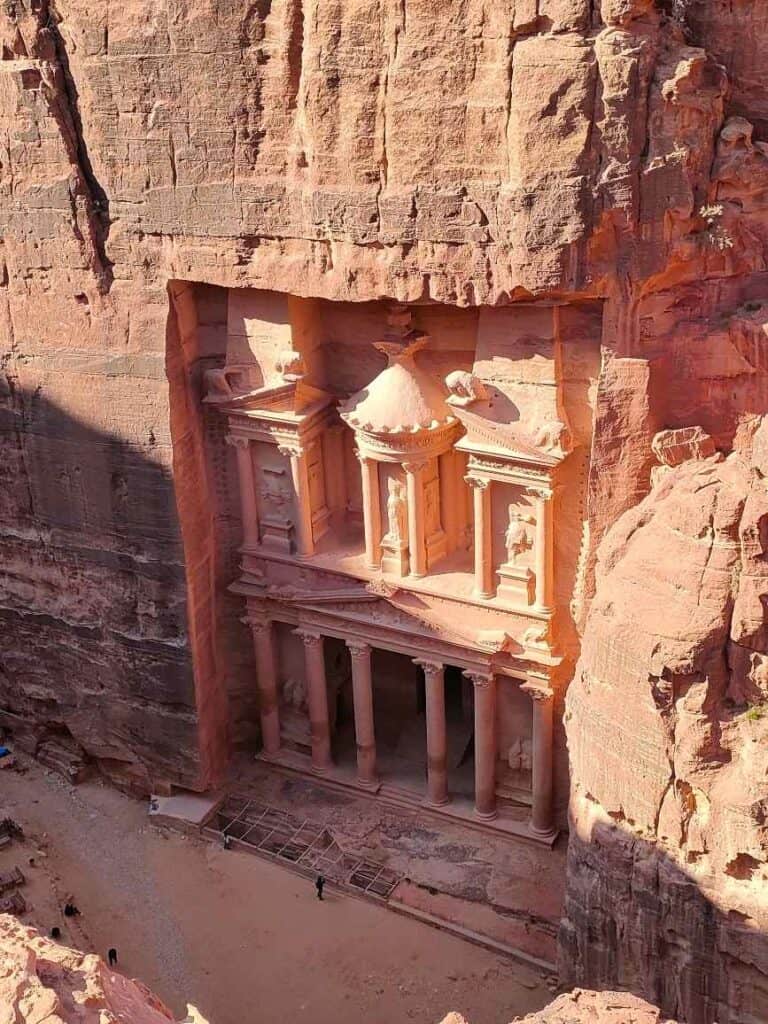
Best photo spots in Petra
The Treasury is where people love posing and even bring an extra dress for a perfect photo. I’m not the traveler who makes an extra effort for an “instagrammable spot”. I prefer observing local people to taking selfies. Some bedouins offer to take you behind the closed area to the top opposite the Treasury. This is where travelers have their well-known photos taken. They ask for 15-20 $ for that.
Funnily, later on, I found myself in the same photo spot along an official trail. So, with some more walking, you can also reach the famous “photo stop” of the Treasury by yourself.
Street of facades
On the road leading to the city center, more than 40 Nabataeans, probably city officials, are buried side by side and above each other. The facades are decorated with Assyrian-styled carvings, cornices, and beautiful pediments. The small interior spaces behind them were used for religious purposes. The steps in the upper part refer to the steep path of the human soul toward the sky.
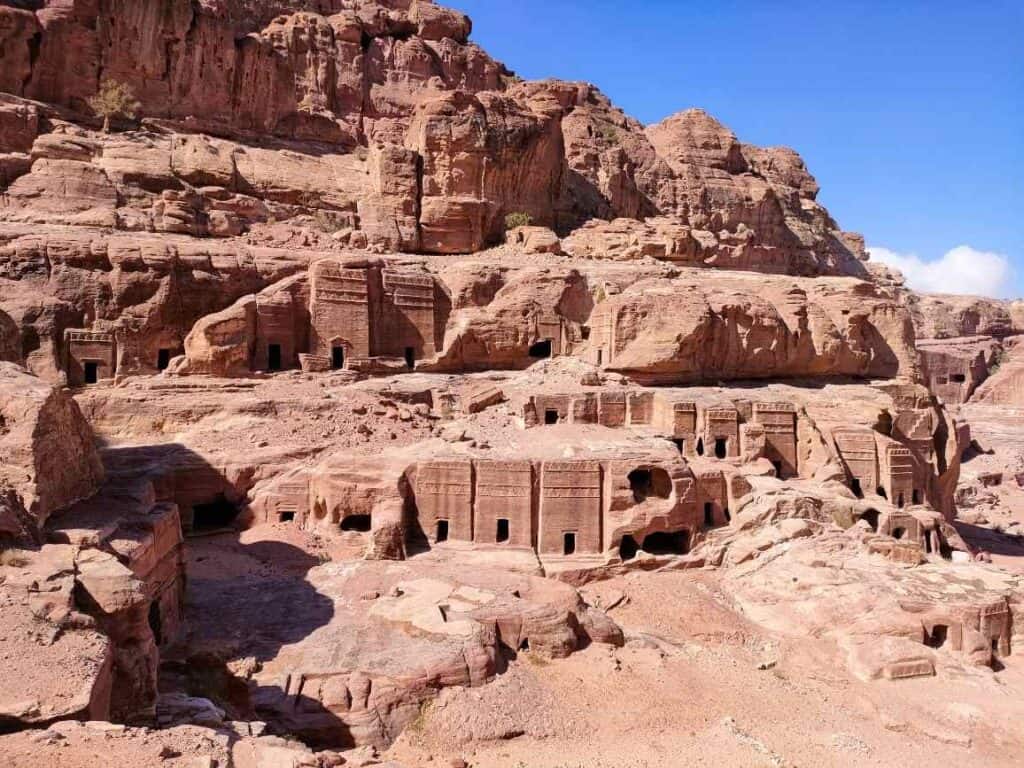
Theatre
The Nabateans, not the Romans, carved the theater around 2000 years ago. The semi-circular auditorium had 45 rows and accommodated 3,000 people who could approach their seats through underground corridors. There is hardly anything left on the stage. 30% of the city’s population, approximately 8,000, could sit in the auditorium. Initially, it was used for religious ceremonies, where they could even hold joint funeral feasts. The theater was severely damaged in the earthquake of 363. Later they used parts of the theater to restore other parts of the city.
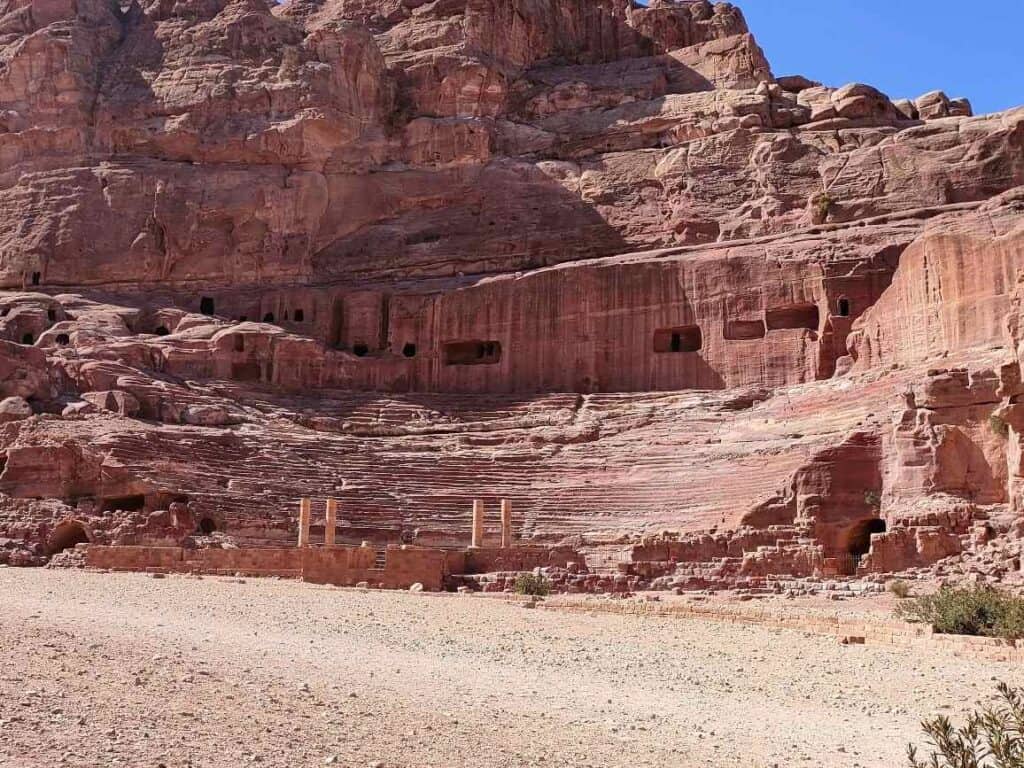
Royal Tombs – Al-Khubtha
The facades of the six royal tombs from the 2nd and 3rd centuries are some of the most beautiful in Petra. They combine Assyrian, Babylonian and Roman styles. Nearby excavations explored a necropolis of pit graves, on top of which the residential buildings were later built. Two English ravelers discovered the graves in 1818. The stairs lead to the Urn grave, and the other graves are to the left of it. (Uneisu, Urn, Silk, Corinthian, Palace, Sextius Florentinus tomb).
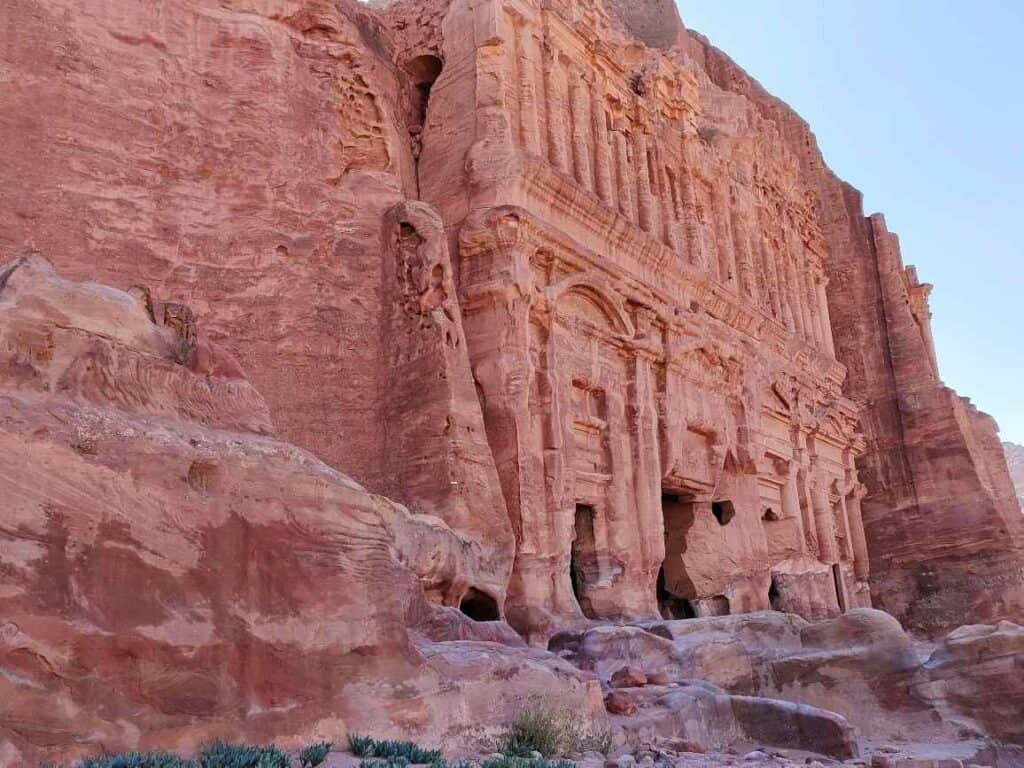
High Place of Sacrifice
They used the altar to offer an animal sacrifice to the Nabatean Gods and collected the blood through channels.
After this, you can return to the main trail the same way, but I recommend continuing along the Wadi Farasa Trail.
Colonnaded Street
Almost nothing remains of the row of arcades that lined the road. The heart of the city, cardo maximus, was built during the reign of Aretas IV and renovated during Trajan’s time, except for a few columns. The trade center was where shops, workshops and residential buildings surrounded the market square. Next to it stands the 1st-century Nabatean church, Qasr al-Bint. On the hill to the right are many ruins – the remains of various public buildings, market halls, sports halls, smaller palaces or churches, and sanctuaries. So far, only a few percent of the ruins have been excavated, and their shape and purpose determined. Petra is still shrouded in mystery.
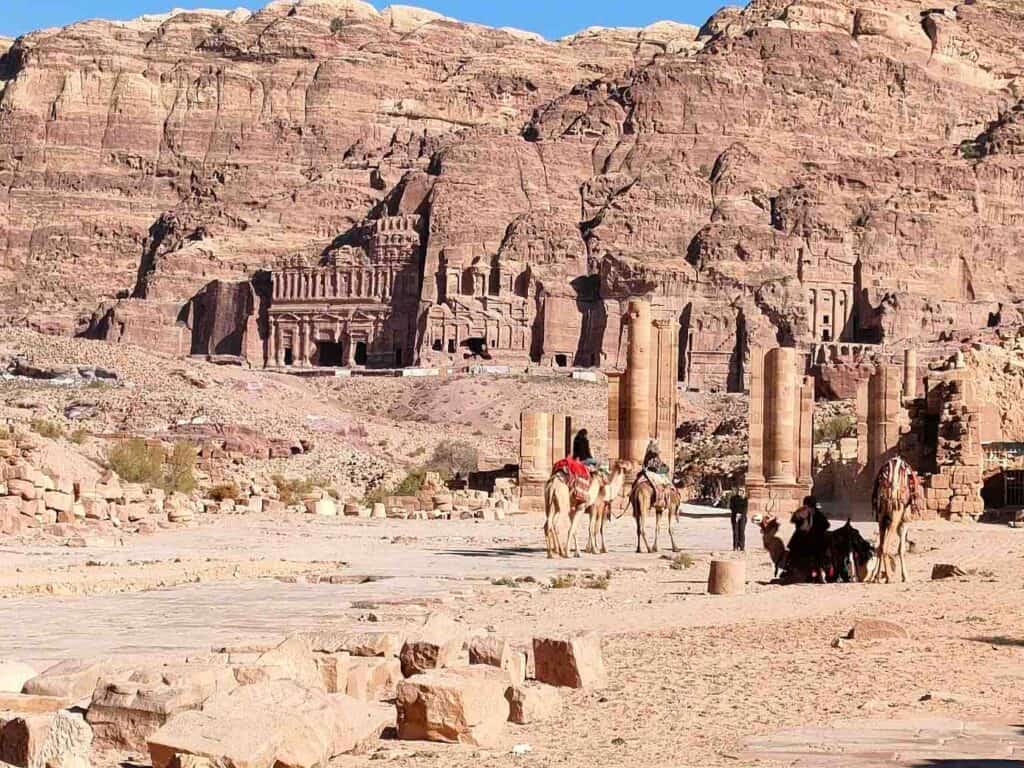
Byzantine church
The first one-nave church was built between 450-500, with an arcaded vestibule in front of its entrance, and 100 years later, it was converted into a three-nave Christian church. The Byzantine Church dates back to the early Christian period. The mosaic floor decoration of the nave, depicting plants, animals, and geometric patterns, is the most beautiful part.
The 150 famous Petra papyrus scrolls were discovered between 537 and 559 at this place.
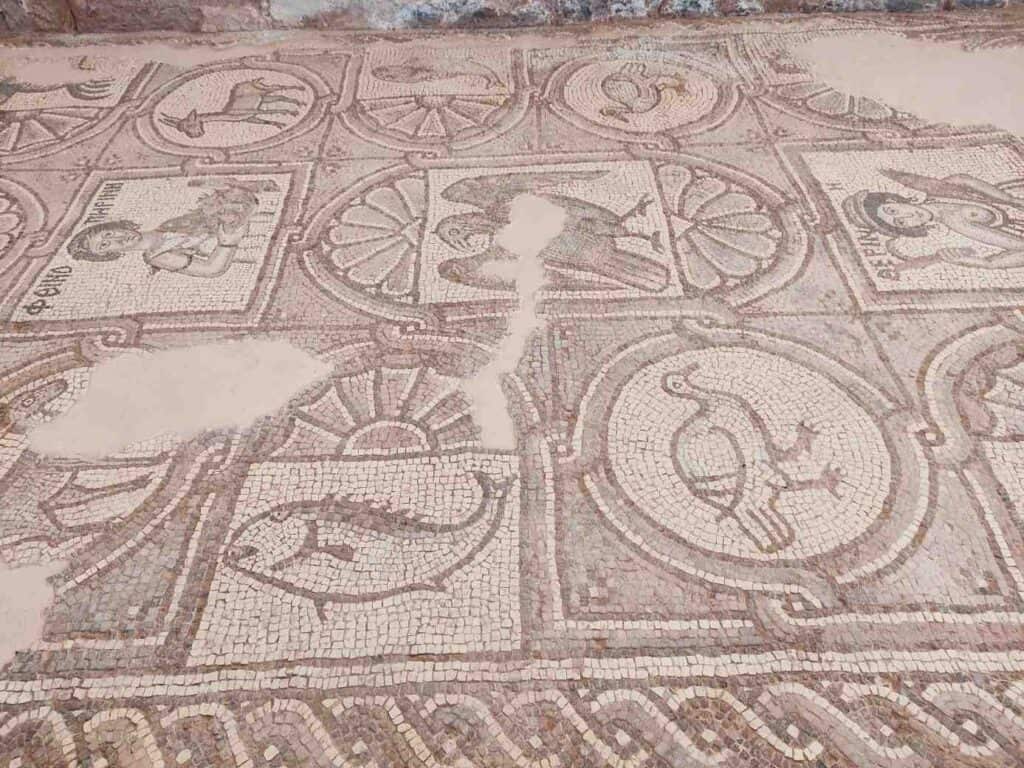
The Great Temple
The Great Temple, next to the Colonnaded Street, occupied the biggest part of the city center. Unlike most buildings in Petra, it was not carved into the rocks. Some impressive columns of the temple are still visible.
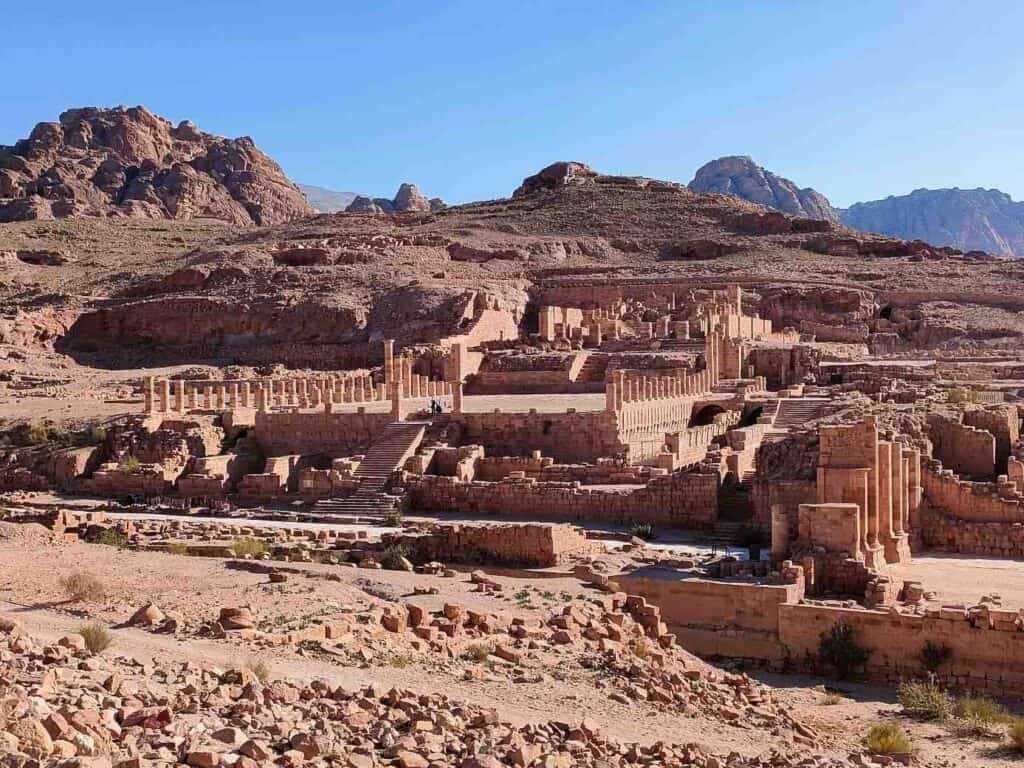
Qasr al-Bint Faroun (Girl’s Palace)
It may have been the largest building in Petra, built around the time of Jesus’ birth. The temple was probably erected to honor the chief god, Dusahra or al-Uzza. Initially, it was ornate, with marble cladding and stucco decorations. At this time, religious ceremonies were no longer held outdoors but in churches. In the central room stood a statue of Dusahra on a pedestal covered with gold, and they performed rituals in the two adjacent halls. According to tradition, the sun cult ceremonies were held under the open sky on the roof terrace of the building.
The pharaoh locked his daughter here with his treasures. It is said to have resembled Solomon’s temple in Jerusalem which was destroyed in the 6th century BC.
Temple of winged lions
The temple dedicated to the Nabatean goddess Atargatis was built in 27 and is a transition from the Nabatean to the Christian religion. It got its name after the decoration of the column capitals or the reliefs next to the entrance. The winged lions replace the usual Corinthian spiral lines. It fell victim to fire and earthquake.
Lion triclinium
After a 10-minute walk, a side path to the left leads to the lion triclinium with a typical Nabatean facade, named after the two lions, the sacred animal of the Nabatean religion guarding the entrance.
Monastery- the best place for sunset
At the end of the Main trail, behind The Basin restaurant, you get to the stairs (800) leading up to the monastery, unique for its monumental size and isolated location.
It is difficult to decide whether it is a church or a tomb, but it must have been an important destination for pilgrims. Priests walked up the mountain path and gathered in the open space in front of the building constructed in the 2nd century. The two-story facade is reminiscent of the Pharaoh’s treasure house.
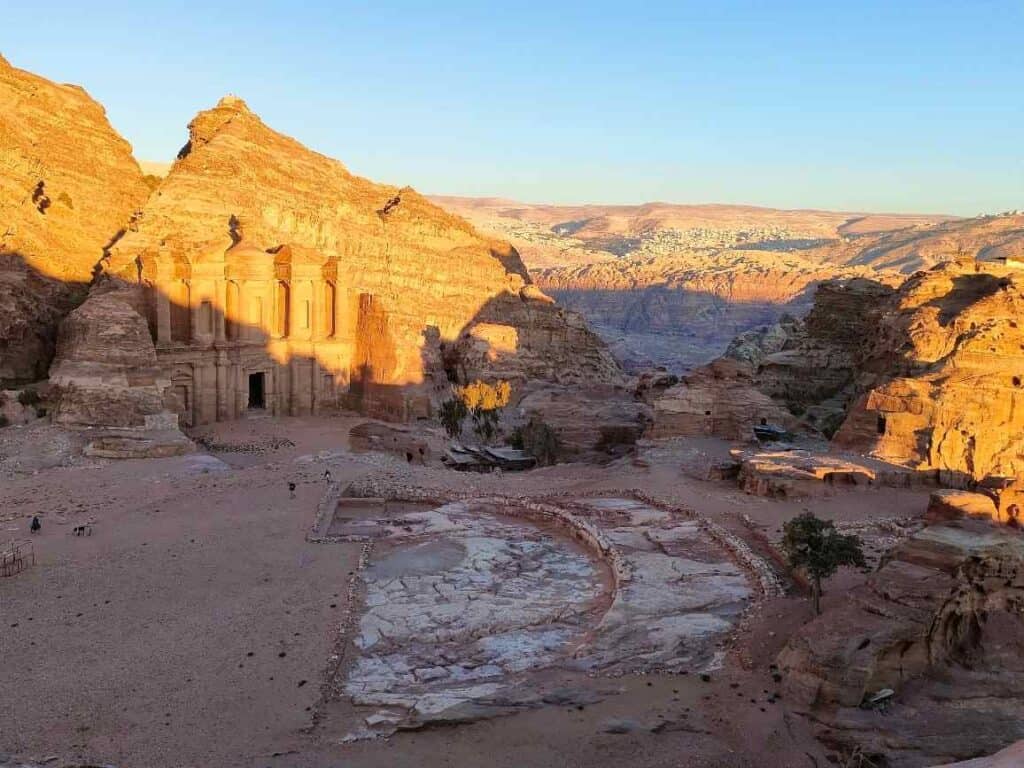
It may have been the tomb of the Nabataean king Rabbel II, who died in 106, and was occupied by monks in the Middle Ages and later by hermits. According to other scholars, it was a temple or a sacred place where the inhabitants occasionally gathered to honor a deity. It was used as a monastery from the 4th century during the Christian Byzantine era.
The monastery was the last significant Nabatean work. A 10-15 minute walk along a path leads to a viewpoint from where you can see the surrounding mountain ranges and the El-Araba valley.
There are several souvenir shops and some tea shops along the way to have rest.
Little Petra
Most tourists don’t come to Little Petra but you shouldn’t miss that. It is a short ride from Wadi Musa, or you can leave Petra in this direction on foot and visit on the way out from the starting point of the monastery Trail (6km long).
Local Bedouins have some souvenir shops and other stalls selling snacks and drinks here.
Like Petra, it was also built by the Nabateans, probably as a house for traders who temporarily stayed in Petra. For centuries after, the Bedouins used the structures as their home. They discovered and restored 2000-year-old frescos in Hellenistic style in one of the caves.
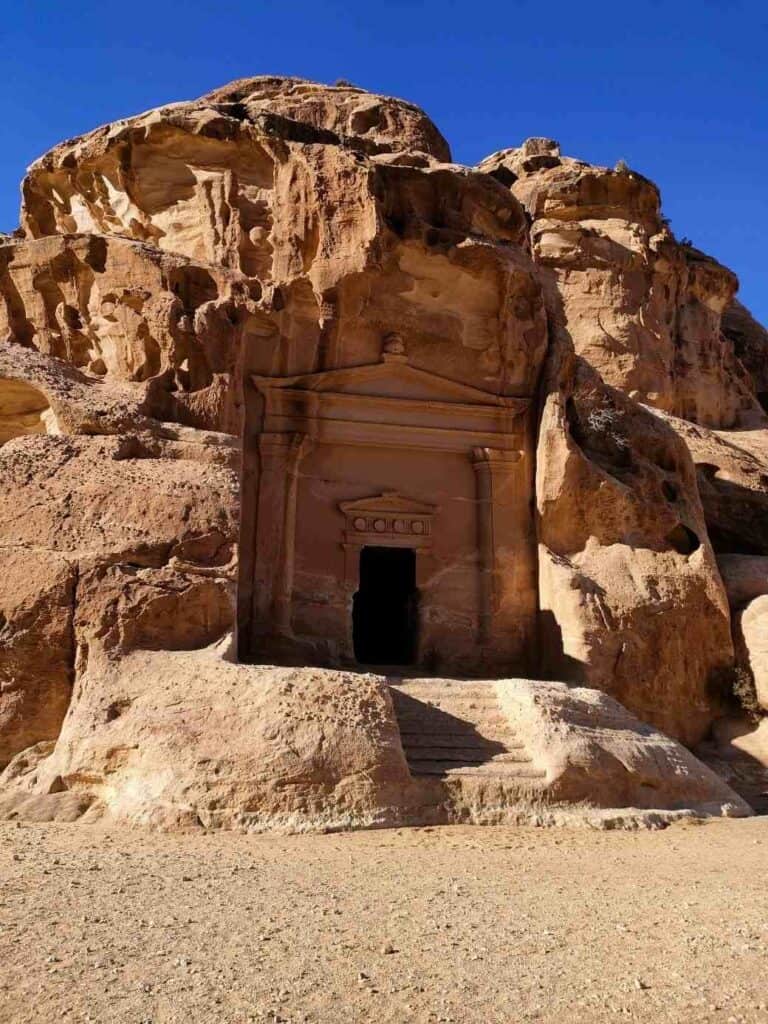
Enter Petra “for free”?
You can enter Petra free through Little Petra, where your ticket is not controlled. From here, you can reach the monastery within 30 minutes. However, security officers occasionally turn up at this point, and officially all visitors must use the official entrance and exit through the visitors’ center.
So, have your ticket to avoid problems and only use this trail to enter or exit Petra with a valid ticket. It is not something you should risk!
Petra by night, is it worth it?
Entrance fee: 17 JOD (your entrance ticket to Petra is not valid for the Petra by night program and is not included in the Jordan Pass)
Time: It starts at 8.30 am every Monday, Wednesday and Thursday from Petra Visitors Center
Duration: 2 hours
A guide takes the visitors along the Siq to the Treasury, where a musician plays an ancient instrument, and Bedouin will share the story of Petra. Candles illuminate the entire route. The show at the Treasury takes 30 minutes.
Honestly, although I had the opportunity, I did not take the Petra by Night program. I was told that it is a little disappointing with so many tourists. Since I was in Petra in February, outside the peak season, it would not have been the case, but after a beautiful day hiking in Petra, I did not feel like doing this “ overly touristic” program for an extra fee.
There are plenty of questions arising concerning what is the best way to visit Petra. I hope this travel guide about visiting Petra answers all your questions about the best Petra itineraries for one and two days and all the things you need to know about the most famous tourist attraction in Jordan. Leave a comment if you have more questions.
Other posts about Jordan
Visiting Jerash, Ajloun and Umm Qais
Jordan desert castles: a day trip from Amman
5, 7 and 10 day Jordan travel itineraries
All you need to know before traveling to Jordan
Other posts about the Middle East
Lebanon
10-day itinerary to visit Lebanon
How to spend 2-3 days in Beirut
Travel guide to Tripoli, Lebanon
Best books to read about Lebanon
Traveling around Lebanon during the economic crisis
Iran
What you can and cannot do in Iran
45 things you must know before traveling to Iran
The best books to read about Iran
The best 2-week itinerary in Iran (the classical route)
All you need to know about the Iranian currency
The best places to visit in Tehran (museums, palaces, religious sites)
The best things to do in Tehran
Travel guide to Tabriz, North Iran
Travel guide to Mashhad, the holy city of Iran
Best things to do in Lahijan, the city of tea in Iran
Best things to do in Ramsar at the Caspian Sea
Visit Varzaneh desert, Toudeshk, Mesr desert and Garmeh from Isfahan
Iraq
All you need to know before traveling to Iraq
What to visit in Baghdad in 3-4 days
The best books to read about Iraq (constantly updated)
Visiting Lalish, the holy place of Yezidi people
How to visit Babylon and other places around Hillah
Most interesting places to visit in Iraq
Pin it for later!
